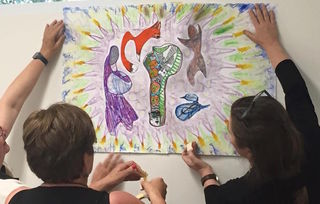Personality
Why Art Therapy Works
A recent study underscores the potential role of art therapy in recovery.
Posted August 30, 2016 Reviewed by Abigail Fagan

As an approach to mental health, art therapy has heavily relied on expert opinion rather than actual evidence via various forms of research. Despite the collective enthusiasm from the profession, there has been very little substantiation that art therapy makes a positive difference in emotional recovery in individuals challenged by personality disorders.
Researchers Haeyan, van Hooren and Hutchemaekers (2015) set out to identify the possible effects of art therapy on the recovery process in groups of adults with personality disorders, based on existing anecdotal observations made by practitioners in the field and patient testimonies. Using Grounded Theory Approach (GTA), they constructed a qualitative study using in-depth interviews to collect data that reflected individuals’ responses to art therapy experiences and used open and axial coding to generate and distill information. For the non-researcher and clinician, this may sound daunting; however, the researchers were able to eventually identify a set of five concepts that encompassed all data collected via interview as follows:
Perception and self-perception. Individuals reported that art expression helped them focus on the present moment, identify emotional responses and experience connections between emotion and body awareness. Although at times this sometimes initially felt worse, the perceptions gained became the first step in recognizing and validating emotions and a starting point for further therapeutic exploration and actions.
Personal integration. Individuals felt that through expression of their experiences in art, identity and self-image were strengthened and more positivity was possible. Perhaps more importantly, art expressions made emotions visible, allowing them to further investigate feelings and thoughts within the course of therapy. Also, conflicting emotions could be brought together in one coherent image, something that is often impossible to do with words alone.
Emotion and impulse regulation. Individuals learned through art expression to modulate emotional responses, thus experiencing more freedom from them and to “dose” and regulate emotions. In other words, art expression offered an experiential space in which individuals could experiment with new responses to difficult feelings, thus increasing a sense of self-confidence and self-efficacy.
Behavior change. In brief, behavior changes include behavior towards oneself and behavior towards others. In this study, many individuals reported that they learned to change their behavioral responses through the process of art expression. How this occurs is still difficult to say, but it may have something to do with the self-directed nature of art expression which involves choices about what to do and how exactly to go about doing it. In other words, art therapy may provide the opportunity to actually practice alternative responses to existing personal narratives.
Because this study focused on small groups, participants also may have learned more about their own behavioral patterns through interaction with others within the context of group art therapy. For example, one 35-year-old female participant noted: “I still remember that one time we all had to draw on one piece of paper. I didn’t like that at all. I wasn’t going to use the whole paper to say, you don’t want to begrudge others their space, but you notice that someone else of going over what you drew (uh…). I couldn’t really deal with that so well…I have been giving myself more space…let others see more of who I am and if someone crosses my boundaries, then I let them know” (p.6).
Insight and comprehension. Individuals reported that art expression helped them to put their emotions and non-verbal experiences into words. Of note, they stated that they “experienced an inner dialogue that guided their choices while working on the art product” (p. 6) as well as after the art expression was completed. In other words, both creating and looking at what was created supported insight and comprehension of emotions, thoughts and behaviors and provided a better understanding of experience through facilitation of the art therapist.
Art therapists might respond to this list by thinking, “well, I could have told you that.” Yes, in fact much of what is summarized above has been repeatedly stated in the field, but mostly through case reports, individual patient testimonies, and enthusiastic, well-meaning believers in what is often referred to as the “magic” of art therapy. However, let’s acknowledge that these researchers have taken an important step forward in identifying just what that magic might be, constructing an integrated theoretical model with five core categories for future investigation. Like all studies, more investigation is needed; for example, how verbal interaction impacts and complements outcomes as well as the effect of group processes also remain questions for further exploration. But undoubtedly this study should ignite a conversation on just how art therapy works to benefit individuals and what relational role the art therapist plays in the mix of art making, individual and practitioner.
Be well,
Cathy A. Malchiodi, PhD, LPCC, LPAT, ATR-BC, REAT
© 2016 Cathy Malchiodi, PhD
References
Suzanne Haeyen, Susan van Hooren, Giel Hutschemaekers, Perceived effects of art therapy in the treatment of personality disorders, cluster B/C: A qualitative study, The Arts in Psychotherapy, Volume 45, September 2015, Pages 1-10, ISSN 0197-4556, http://dx.doi.org/10.1016/j.aip.2015.04.005.




